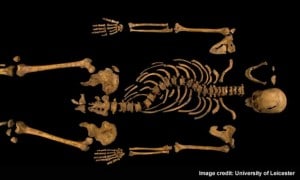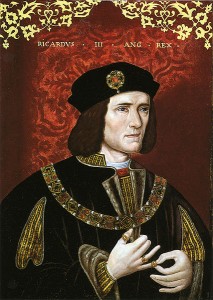
Yes, DNA test results have proved that the remains found in the Grey Friars archaeological dig are those of Richard III.
I watched the press conference live on BBC News 24 and listened to them on BBC Radio Leicester at the same time (good job I did as the BBC interrupted their coverage for other breaking news!) and here are the main points:
The Remains
- The remains were found in front of the Grey Friars’ choir stalls so were a prime candidate for Richard III.
- The skeleton was well preserved and substantially complete – It was just missing its feet.
- The hands were crossed, which was not consistent with other medieval burials, so the hands may have been tied.
- Carbon dating of the bones gave a model date of 1455-1540.
- Skeletal remains showed that the person had a slender, almost feminine, build, was in their late 20s to late 30s, was around 5’8 in height but had scoliosis of the spine which would have made them substantially shorter in reality. All of this was in keeping with what we know about Richard – aged 32, slender build and some type of spinal abnormality. There was no evidence of a withered arm, it was completely normal.
- There was trauma to the skeleton – 10 wounds were found, 8 on the skull and 2 on the body. They occurred at death and shortly after death.
- Main skull injuries – There was a penetrating wound to the top of the skull which was consistent with a non-fatal blow to the head. There was also a large wound at the base of the skull which was consistent with a bladed weapon, such as a halberd. A third injury to the skull was also consistent with a blow from a bladed weapon. Wounds two and three would have caused “almost instant loss of consciousness and death would have followed shortly afterwards”.
- Further skull injuries – These consisted of a wound on the cheekbone, probably caused by a dagger, and a wound to the jaw, caused by a bladed weapon. They would have caused blood loss but were not fatal. They are not consistent with the person wearing a helmet at the time so could be humiliation injuries.
- Injuries to the body – There had been a blow to the ribs and a a dagger blow to the right pelvis. The pelvic injury is consistent with a dagger being thrust from behind, upwards into the right buttock. The ribs and buttocks would have been protected by armour during the battle so these wounds could be humiliation injuries. We know that Richard III’s body was flung over the back of the horse, so this would have been an ideal opportunity for his enemies to cause these injuries.
- It was concluded that the remains were highly consistent with what we know about Richard III in life and the circumstances of his death.
The DNA Results
Professor Kevin Schurer explained the background to the DNA testing, explaining that the team had tracked down four living male descendants of Henry Somerset, 5th Duke of Beaufort, for the male line from Edward III, a living descendant of Anne of York (Michael Ibsen) and also living descendants of a second maternal line.
Dr Turi King then explained the DNA results, noting that the individuals of the maternal line were the last of their line so in another generation these tests could not have been done. Dr King went on to explain that the team did manage to obtain DNA from the remains and although it was too early to say whether the DNA matched the male line, tests showed that the remains were male. Michael Ibsen’s DNA results confirmed that he was a descendant of Anne of York and lineage two also matched. The family tree was verified. It was then a case of comparing the DNAs of the maternal line with those of the remains….
There was a match between the remains and descendants of Richard III’s family. Dr King concluded that the DNA evidence pointed to the remains being Richard III.
Richard III Found!
 Richard Buckley, lead archaeologist, concluded that “beyond reasonable doubt the individual exhumed at Grey Friars on September 12th is indeed Richard III, the last Plantagenet king of England”.
Richard Buckley, lead archaeologist, concluded that “beyond reasonable doubt the individual exhumed at Grey Friars on September 12th is indeed Richard III, the last Plantagenet king of England”.
What Happens Now?
It was confirmed that Richard III’s remains will be re-interred at Leicester Cathedral, the nearest consecrated ground to where he was found. From February 8th there is going to be a temporary exhibition there and then a permanent exhibition at a special visitors’ centre, which will open next year. The King will be given a fitting resting place and the Richard III Society have already received a donation of £10,000 for his tomb.
If you have access to Channel 4 then don’t forget to watch the programme Richard III: The King in the Car Park at 9 o’clock tonight.
More news on the press conference and findings can be found at:
Update
The Channel 4 programme unveiled the reconstruction of Richard III’s face last night and you can see photos at http://news.sky.com/story/1047715/richard-iii-kings-face-is-revealed and http://www.bbc.co.uk/news/uk-england-leicestershire-21328380